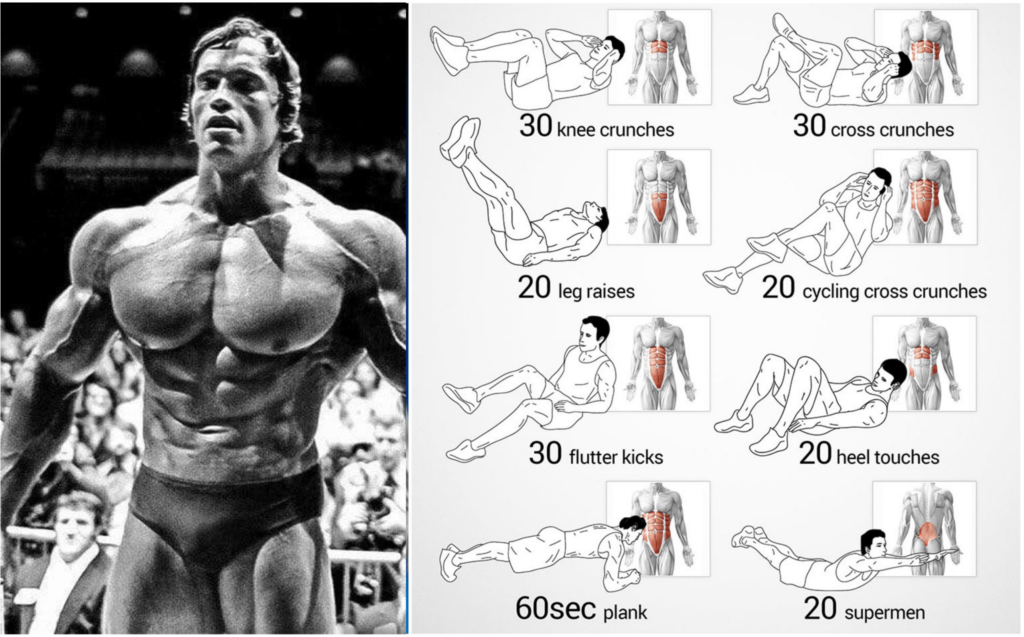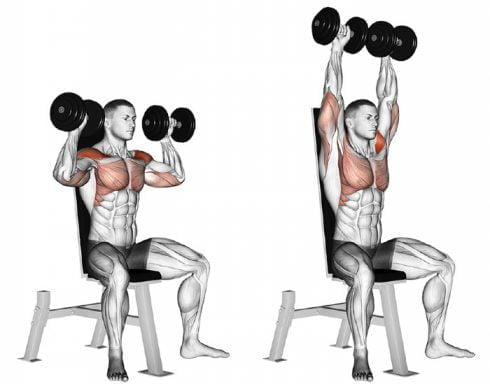Introduction
Resistance bands are elastic bands that are often used in strength training and physical therapy to add resistance to exercises. They come in different sizes, lengths, and levels of resistance, making them a versatile tool for various exercises. Resistance Band Leg Workouts are a popular and effective way to work out the lower body muscles, including the glutes, hamstrings, quads, and calves.
Benefits of using resistance bands for leg workouts
Resistance Band Leg Workouts have numerous benefits for the legs, including:
- Improved Muscle Strength: Resistance bands can provide varying degrees of resistance, making them an effective tool for building leg muscle strength. They help to activate and engage more muscle fibers, which leads to increased muscle growth and strength.
- Versatility: Resistance bands can be used for a variety of leg exercises and can be easily adjusted to target different muscle groups. This versatility allows for a more well-rounded and balanced leg workout.
- Injury Prevention: Resistance bands are a low-impact option for leg workouts, which reduces the risk of injury. Additionally, they can be used for rehabilitation exercises to help prevent future injuries.
- Portability: Resistance bands are lightweight and compact, making them a convenient option for leg workouts on-the-go or at home.
- Affordable: Compared to traditional gym equipment, resistance bands are a cost-effective option for building leg strength and muscle.
- Improved Balance and Stability: Using resistance bands during leg exercises can help improve balance and stability, as it requires the activation of smaller stabilizing muscles in the legs and core.
- Increased Flexibility: Resistance band leg exercises can also help increase flexibility and range of motion in the legs. This can be particularly helpful for those who spend a lot of time sitting or have tight muscles.
- Time Efficiency: Resistance band leg workouts can be done quickly and efficiently, making them a great option for those with busy schedules. They can also be easily integrated into other workouts, such as cardio or full-body strength training.
- Progression: Resistance bands offer a progressive level of resistance that can be adjusted as the muscles become stronger, allowing for continued muscle growth and development.
In summary, Resistance Band Leg Workouts provide a wide range of benefits that can help improve leg strength, balance, stability, flexibility, and overall fitness. Plus, they are an affordable, versatile, and convenient option for at-home or on-the-go workouts.
Basic Resistance Band Exercises for Legs
Here are some basic Resistance Band Leg Workouts that you can try:
- Squats: Place the resistance band under both feet, shoulder-width apart. Hold the ends of the band with both hands at shoulder height. Keeping your back straight, lower your hips until your thighs are parallel to the ground, then push back up to starting position.
- Lunges: Stand with one foot in front of the other and the resistance band looped under the front foot. Hold the ends of the band with both hands at shoulder height. Keeping your back straight, lower your back knee towards the ground, then push back up to starting position. Switch legs and repeat.
- Leg press: Lie down on your back with the resistance band looped around the soles of your feet. Hold the ends of the band with both hands and push your feet away from your body until your legs are fully extended. Slowly bend your knees and return to starting position.
- Glute bridges: Lie down on your back with the resistance band looped around your thighs, just above your knees. Place your feet on the ground, hip-width apart. Push your hips up towards the ceiling, squeezing your glutes at the top, then lower back down to starting position.
- Leg extensions: Sit on a chair with the resistance band looped around one foot. Hold the ends of the band with both hands and extend your leg until it is straight in front of you, then slowly lower back down to starting position. Switch legs and repeat.
- Calf raises: Stand with the resistance band looped under both feet, shoulder-width apart. Hold the ends of the band with both hands at hip height. Lift your heels off the ground as high as possible, then lower back down to starting position.
- Side leg lifts: Lie down on your side with the resistance band looped around your ankles. Keep your bottom leg bent for support and lift your top leg as high as possible, then slowly lower back down to starting position. Switch sides and repeat.
- Seated leg curls: Sit on the edge of a chair with the resistance band looped around one ankle. Hold the ends of the band with both hands and curl your leg towards your body as far as possible, then slowly lower back down to starting position. Switch legs and repeat.
These basic resistance band exercises for legs are great for beginners and can be easily modified for different fitness levels. Remember to always use proper form and gradually increase the resistance as you progress.
Advanced Resistance Band Exercises for Legs
Here are some advanced Resistance Band Leg Workouts that you can try:
Bulgarian Split Squats with Resistance Bands
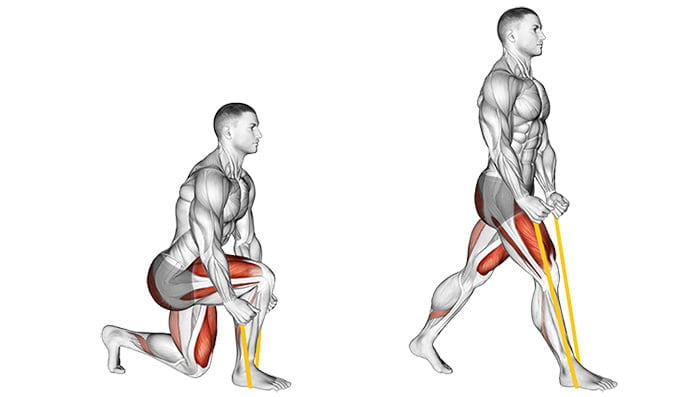
- Loop a resistance band around a stable anchor and place your front foot on the band.
- Hold the other end of the band in your opposite hand.
- Perform a split squat by lowering your back knee towards the ground while keeping your front knee over your ankle.
- As you rise back up, pull the resistance band up towards your body for an extra challenge.
- Repeat on the other side.
Side-Lying Leg Lifts with Resistance Bands
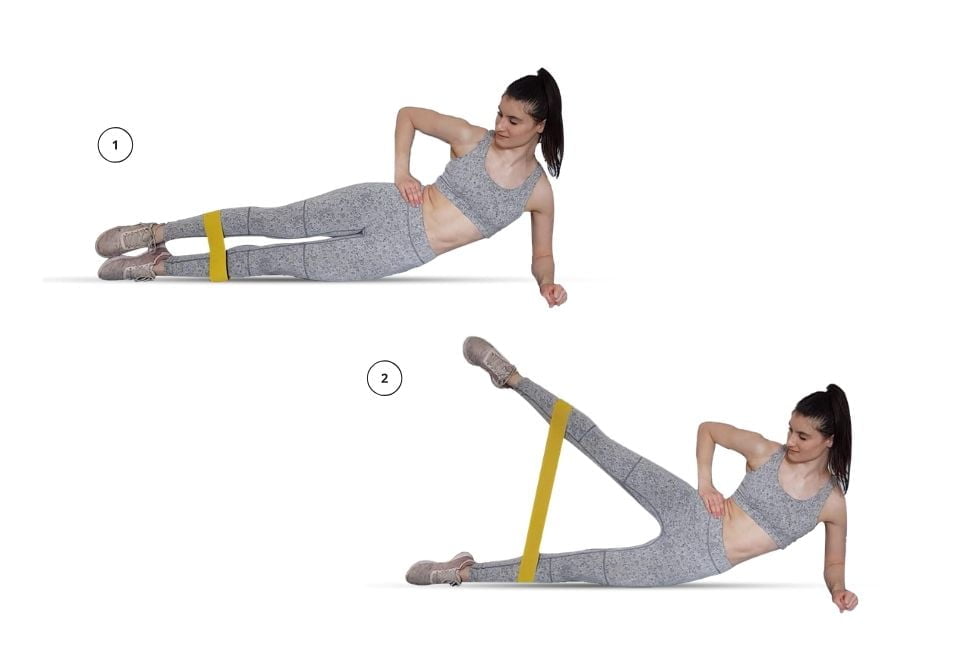
- Loop a resistance band around your ankles and lie on your side with your legs straight.
- Lift your top leg up towards the ceiling while keeping your hips stacked.
- Lower your leg back down with control and repeat on the other side.
Standing Hip Abductions with Resistance Bands
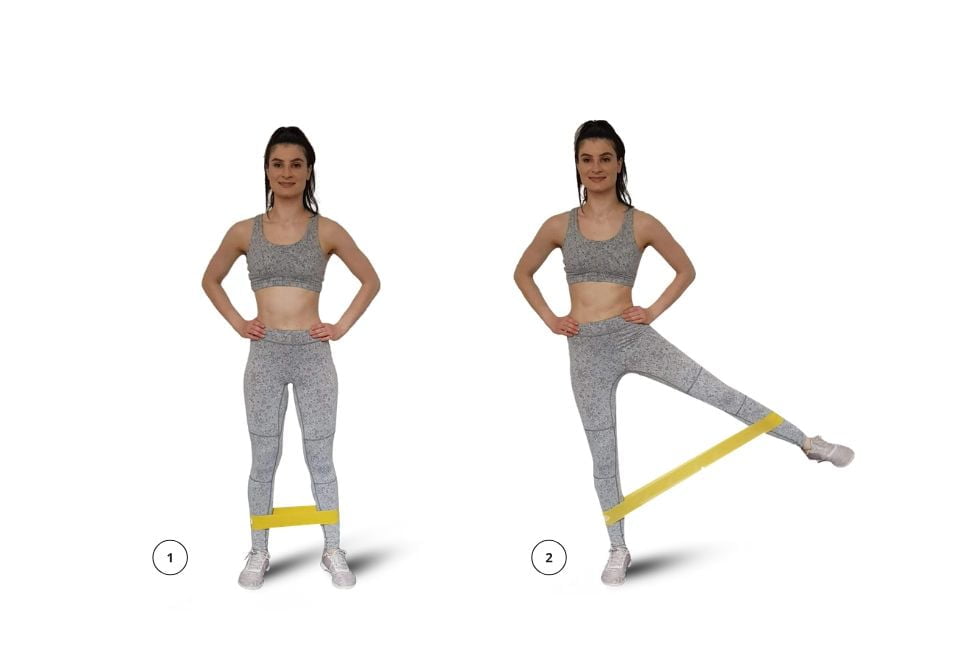
- Loop a resistance band around your ankles and stand with your feet hip-width apart.
- Lift one leg out to the side, keeping your knee straight.
- Lower your leg back down with control and repeat on the other side.
Single-Leg Deadlifts with Resistance Bands
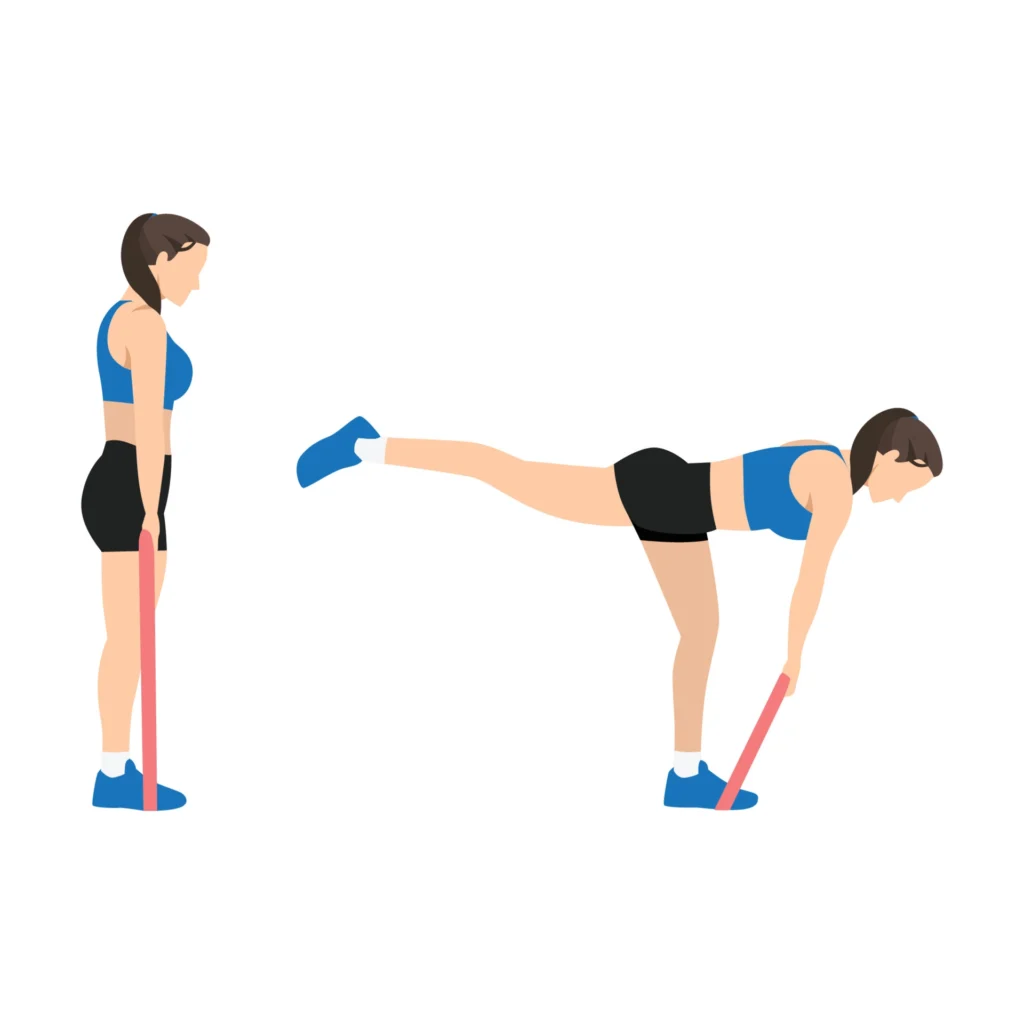
- Loop a resistance band around the arch of your back foot and hold the other end in the opposite hand.
- Hinge at your hips and lower your torso towards the ground while lifting your back leg behind you.
- As you stand back up, pull the resistance band towards your body.
- Repeat on the other side.
Resistance Band Jump Squats
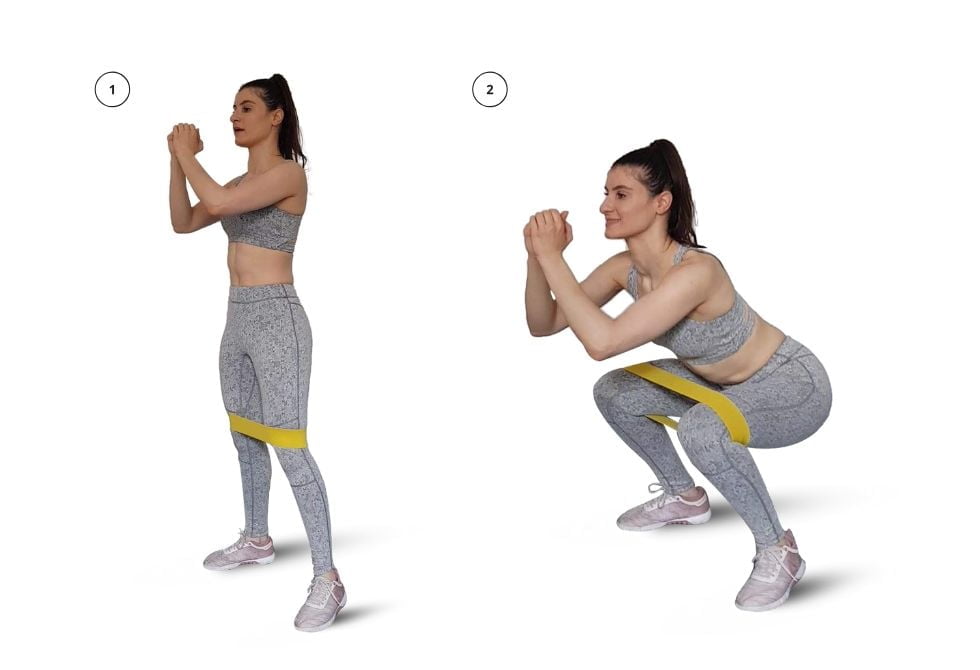
- Place a resistance band around your thighs, just above your knees.
- Stand with your feet shoulder-width apart and perform a squat.
- As you rise back up, jump up explosively while keeping tension on the resistance band.
- Land softly and repeat.
Single-Leg Glute Bridges with Resistance Bands
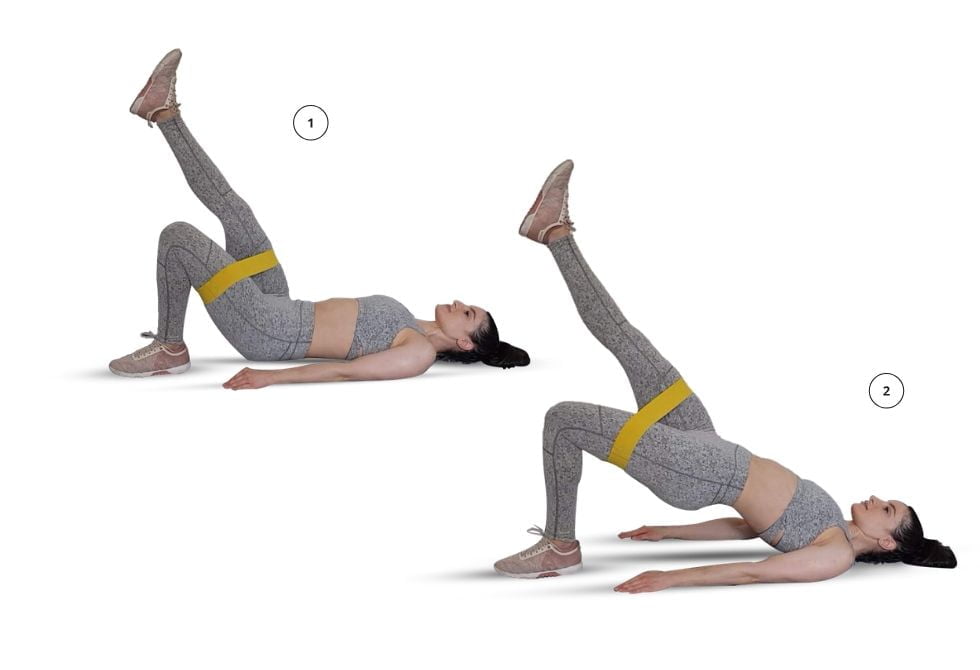
- Loop a resistance band around your thighs, just above your knees.
- Lie on your back with your knees bent and feet flat on the ground.
- Lift one leg off the ground and perform a glute bridge by lifting your hips towards the ceiling.
- Squeeze your glutes at the top and lower back down with control.
- Repeat on the other side.
Resistance Band Side Shuffle

- Place a resistance band around your ankles.
- Lower into a quarter squat and take small steps to the side while keeping tension on the band.
- Shuffle to one side for 10-15 steps and then back to the other side.
Resistance Band Leg Curls
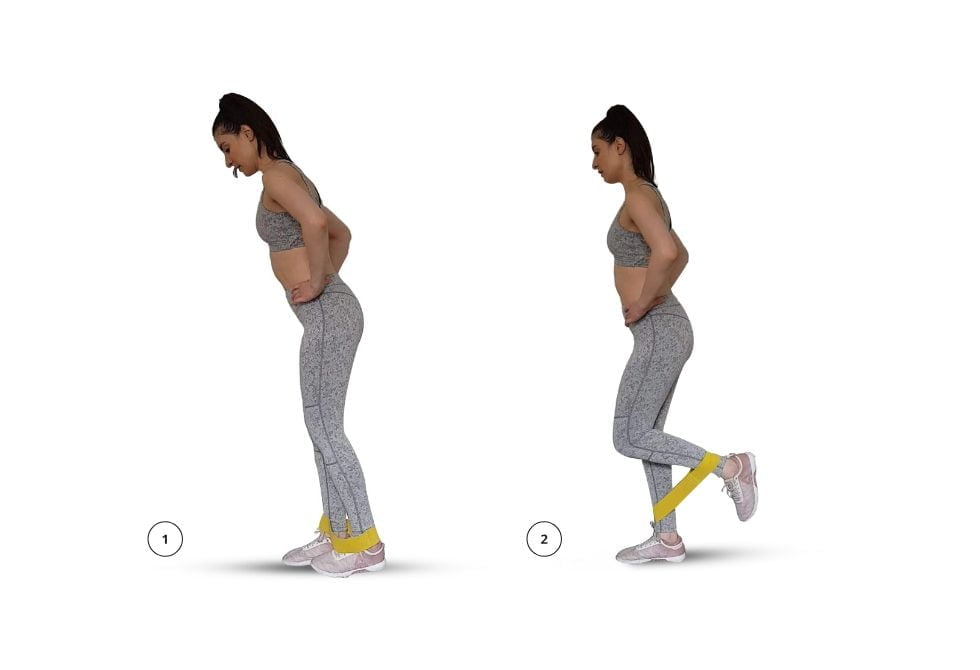
- Loop a resistance band around a stable anchor and lie face down with your feet in the band.
- Curl your legs up towards your glutes, keeping your hips pressed into the ground.
- Lower back down with control and repeat.
Resistance Band Leg Workout Routines
Here are three resistance band leg workout routines that you can try:
Beginner Resistance Band Leg Workout Routine:
- Squats – 3 sets of 12 reps
- Lunges – 3 sets of 12 reps (per leg)
- Glute bridges – 3 sets of 12 reps
- Leg press – 3 sets of 12 reps
- Leg extensions – 3 sets of 12 reps
Intermediate Resistance Band Leg Workout Routine:
- Bulgarian split squats – 3 sets of 10 reps (per leg)
- Standing hip abductions – 3 sets of 12 reps (per leg)
- Resistance band jump squats – 3 sets of 12 reps
- Side-lying leg lifts – 3 sets of 15 reps (per leg)
- Glute bridges with resistance band – 3 sets of 12 reps
Advanced Resistance Band Leg Workout Routine:
- Single-leg deadlifts with resistance band – 3 sets of 8 reps (per leg)
- Resistance band jump squats with lateral leg raise – 3 sets of 10 reps (per leg)
- Standing hip adductions with resistance band – 3 sets of 12 reps (per leg)
- Resistance band leg press – 3 sets of 12 reps
- Glute bridge with alternating leg extension – 3 sets of 12 reps (per leg)
Remember to choose a resistance band that challenges you but doesn’t compromise your form. Start with a lower resistance band and gradually increase the resistance as you progress. Resistance band leg workouts are great for targeting and strengthening the lower body muscles, improving balance and stability, and can be done from the comfort of your own home.
Tips for Safe and Effective Resistance Band Leg Workouts
When it comes to Resistance Band Leg Workouts, it’s important to follow some tips to ensure that you are performing the exercises safely and effectively:
- Choose the right resistance band: Make sure to choose a resistance band with appropriate resistance level for your fitness level and goals.
- Proper form and technique: Focus on proper form and technique while performing Resistance Band Leg Workouts to maximize the effectiveness of the exercise and minimize the risk of injury.
- Warm up before starting: It’s essential to warm up before performing any resistance band leg workout to prepare your muscles for the workout.
- Gradually increase resistance and intensity: To avoid injuries, it’s important to gradually increase the resistance and intensity of your resistance band leg workout over time.
- Listen to your body: If you experience any pain or discomfort during Resistance Band Leg Workouts, stop immediately and consult a medical professional.
- Incorporate variety: To prevent boredom and maximize the benefits of Resistance Band Leg Workouts, incorporate a variety of exercises that target different muscle groups in your legs.
- Use a stable surface: When performing Resistance Band Leg Workouts, use a stable surface such as a bench or a chair to provide support and balance.
- Control the resistance: Control the resistance of the band throughout the entire range of motion to get the most out of each exercise.
By following these tips, you can ensure that your Resistance Band Leg Workouts are safe and effective, and help you achieve your fitness goals.
Resistance Band Leg Workouts for Specific Goals
Resistance Band Leg Workouts can be customized to help individuals achieve their specific fitness goals. Whether the goal is to build strength, tone and shape the legs, or improve flexibility and mobility, resistance band exercises can help target the major muscle groups in the legs, including the quadriceps, hamstrings, and glutes.
For those looking to build strength, resistance band squats and lunges are effective exercises to include in a leg workout routine. These exercises can be done with a heavier resistance band to provide added resistance and challenge to the muscles, helping to build strength and improve overall fitness.
To tone and shape the legs, resistance band leg press and glute bridge exercises can be incorporated into a leg workout routine. These exercises target the muscles in the thighs and glutes, helping to activate and strengthen them, resulting in a leaner and more toned appearance.
Resistance band leg workouts can also be used to improve flexibility and mobility. Exercises such as resistance band leg extensions and side-lying leg lifts can help improve range of motion and reduce the risk of injury. These exercises can be done with a lighter resistance band to allow for more focus on proper form and technique.
By customizing resistance band leg workouts to specific fitness goals, individuals can achieve the results they desire while also improving their overall fitness and well-being. It is important to note that regardless of the specific goal, proper form and technique should always be prioritized to ensure a safe and effective workout.
Resistance Band Leg Workouts for Home Workouts
Resistance Band Leg Workouts are an excellent option for home workouts since they are portable, affordable, and can provide an effective workout for the lower body. Here are a few Resistance Band Leg Workouts that you can try at home:
- Resistance Band Squats: Loop the Resistance Band around your thighs just above your knees. Stand with your feet shoulder-width apart and keep your toes pointing slightly outward. Squat down while pushing your knees out against the resistance of the band. Stand back up to complete one rep. Aim for three sets of 10-12 reps.
- Resistance Band Lunges: Place the Resistance Band around your ankles. Take a large step forward with your right leg and bend both knees to lower into a lunge position. Push back up to the starting position and repeat with your left leg. Aim for three sets of 10-12 reps on each leg.
- Resistance Band Glute Bridges: Lie on your back with your knees bent and feet flat on the floor. Place the Resistance Band around your thighs just above your knees. Raise your hips off the ground until your body forms a straight line from your knees to your shoulders. Squeeze your glutes at the top and slowly lower back down. Aim for three sets of 12-15 reps.
Remember to choose a resistance band with a tension level that is challenging but allows you to complete the exercises with proper form. Also, focus on proper form and gradually increase the intensity of the exercises over time as you become more comfortable and stronger.
Resistance Band Leg Workouts for Sports Performance
Resistance Band Leg Workouts can be an effective training tool to enhance sports performance for athletes. Here are some examples of Resistance Band Leg Workouts for specific sports:
- Runners: Resistance Band Leg Workouts can help improve running speed, agility, and power. Examples of exercises include Resistance Band Lateral Leg Walks, Resistance Band Jump Squats, and Resistance Band Straight-Leg Deadlifts.
- Basketball Players: Resistance Band Leg Workouts can help basketball players improve their vertical jump and overall lower body strength. Exercises that are beneficial include Resistance Band Squat Jumps, Resistance Band Box Jumps, and Resistance Band Lateral Lunges.
- Soccer Players: Resistance Band Leg Workouts can help soccer players improve their agility, balance, and lower body strength. Exercises that can be beneficial for soccer players include Resistance Band Single Leg Deadlifts, Resistance Band Lateral Leg Raises, and Resistance Band Side Shuffles.
By incorporating Resistance Band Leg Workouts into their training routine, athletes can improve their overall athletic performance, prevent injury, and enhance their endurance and power on the field or court.
Resistance Band Leg Workouts for Injury Prevention and Rehabilitation
Resistance Band Leg Workouts can be a great way to prevent knee and ankle injuries, as well as rehabilitate from existing injuries. Here are some examples of resistance band leg exercises that can help:
- Resistance band side steps: Place a resistance band around your ankles and take sideways steps, keeping your knees slightly bent. This exercise can help strengthen the muscles around your knees and ankles, reducing the risk of injury.
- Resistance band leg extensions: Sit on a chair with a resistance band looped around one ankle and anchored to the chair leg. Extend your leg out straight, hold for a few seconds, and then release. This exercise can help improve strength and stability in the knee joint.
- Resistance band calf raises: Stand on a resistance band with your feet hip-width apart and hold the ends of the band in each hand. Raise up onto your toes, hold for a few seconds, and then release. This exercise can help strengthen the calf muscles, which can help prevent ankle injuries.
- Resistance band hamstring curls: Lie on your stomach with a resistance band looped around one ankle and anchored to a sturdy object. Bend your knee and lift your heel towards your buttocks, hold for a few seconds, and then release. This exercise can help improve strength and flexibility in the hamstring muscles, which can help prevent knee injuries.
It’s important to note that resistance band leg workouts for injury prevention and rehabilitation should be done under the guidance of a qualified healthcare professional, such as a physical therapist or sports medicine doctor, to ensure safety and effectiveness.
FAQs
Q: Can resistance band leg workouts build muscle?
A: Resistance Band Leg Workouts can indeed help build muscle. When resistance bands are used correctly, they can create significant resistance, leading to muscle growth and strength gains in the legs. By gradually increasing the resistance of the bands over time, you can continue to challenge your muscles and promote muscle growth. Some of the best resistance band leg exercises for building muscle include squats, lunges, and leg press.
Q: How many times a week should I do resistance band leg workouts?
A: The frequency with which you should perform Resistance Band Leg Workouts depends on your fitness goals and overall level of fitness. If you’re a beginner, it’s recommended to start with 1-2 workouts per week and gradually increase as you become more comfortable with the exercises. Intermediate and advanced athletes can aim for 2-3 Resistance Band Leg Workouts per week to see optimal results. However, it’s important to allow your muscles adequate rest and recovery time in between workouts to prevent overtraining and injury.
Q: Can resistance band leg workouts be used as a warm-up before other exercises?
A: Yes, Resistance Band Leg Workouts can be an effective way to warm up before other exercises. Using resistance bands before a workout can help activate the muscles in your legs, increase blood flow, and prepare your body for the more intense exercises that follow. Leg exercises like squats and lunges with resistance bands can help improve your range of motion and get your heart rate up, making them a great addition to a warm-up routine. However, it’s important to start with lighter resistance bands and gradually increase the intensity to avoid fatigue and overuse injuries.
Conclusion
Recapping some of these benefits, resistance band leg workouts are highly versatile, cost-effective, and can be done almost anywhere, making them ideal for home workouts or when traveling. They can also be easily adjusted to suit different fitness levels and goals, from beginners to advanced athletes.
Incorporating resistance band leg workouts into a well-rounded fitness routine can help improve lower body strength, increase muscular endurance, tone and shape legs, improve flexibility and mobility, and prevent injuries.
So if you are looking for an effective and convenient way to enhance your leg workouts, resistance band leg exercises are definitely worth considering. Whether you are a beginner or an experienced fitness enthusiast, Resistance Band Leg Workouts can help take your leg training to the next level!

Good day, and welcome to Fitthour. My name is Shubham Vijay, and I am a certified personal trainer and nutrition coach with 6 years of experience in the fitness industry. At Fitthour, we specialize in types of training, such as strength training, cardio, or HIIT, and our mission is to help clients achieve their fitness goals and improve their overall health.

